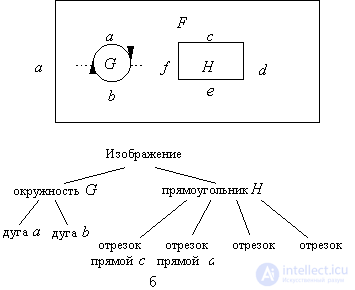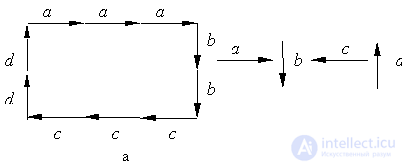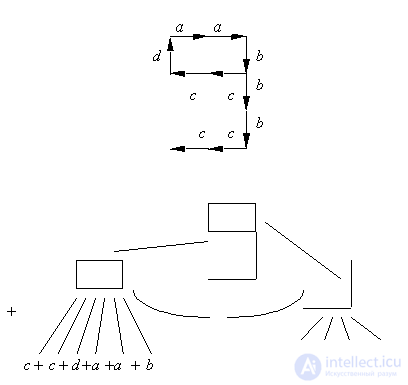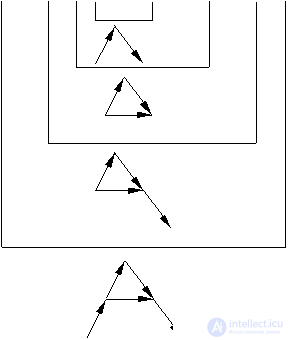Lecture
In the structural approach, objects are not described by a set of numerical values of features.  , and the structure of the object. In fig. 9 shows the image and description of its hierarchical structure.
, and the structure of the object. In fig. 9 shows the image and description of its hierarchical structure.

Fig. 9. Image (a) and its hierarchical
structural description (b)
Hierarchy involves the description of complex objects using more simple subobjects. Those, in turn, can be described using sub-objects of the next level, etc. This approach is based on the analogy between the structure of objects and the syntax of languages. It is acceptable when the simplest sub-objects are easier to distinguish and recognize than the image (object) as a whole. The rules of composition of the simplest (non-derivative) elements in describing an object as a whole are called the grammar of the object description language. The recognition of an object consists in the recognition of its non-derivative elements and in the syntactic analysis (grammatical analysis) of the "sentence" describing the given object.
The advantage of the linguistic approach is manifested if a large number of complex objects can be represented with the help of a small number of non-derivative elements and grammatical rules (for example, the recognition of oral words by a sequence of phonemes). In fig. 10 shows an example of the description of an object (a) using the composition of "making a chain" of non-derivative elements (b): 

Fig. 10. Rectangle (a) and its non-derivative elements (b)
In fig. 11 shows a more complex example of the structural description of the number 9.

Fig. 11. Image of figure 9 and its structural description
The grammar of the object description language is formed at the training stage on the basis of a training set. The theoretical basis of this approach is the theory of formal languages and the underlying grammars.
As an example, we present fragments of the PDL image description language (Picture Description Language). Non-derivative elements identified
 ,
,
having different head and tail points, as well as four binary operators of connecting elements into chains:

In fig. 12 shows a PDL expression describing the letter  .
.
We will not consider this approach in more detail. We only note that often the structural approach is combined with the previously considered ones. Thus, oral words are recognized by a sequence of phonemes on the basis of a structural method, and phonemes are extracted and recognized in a multidimensional attribute space.  using one or another decision rules.
using one or another decision rules.
More detailed information on the structural approach can be found in the literature recommended for self-study [9].








Fig. 12. Structural description of the letter A in PDL
Comments
To leave a comment
Pattern recognition
Terms: Pattern recognition